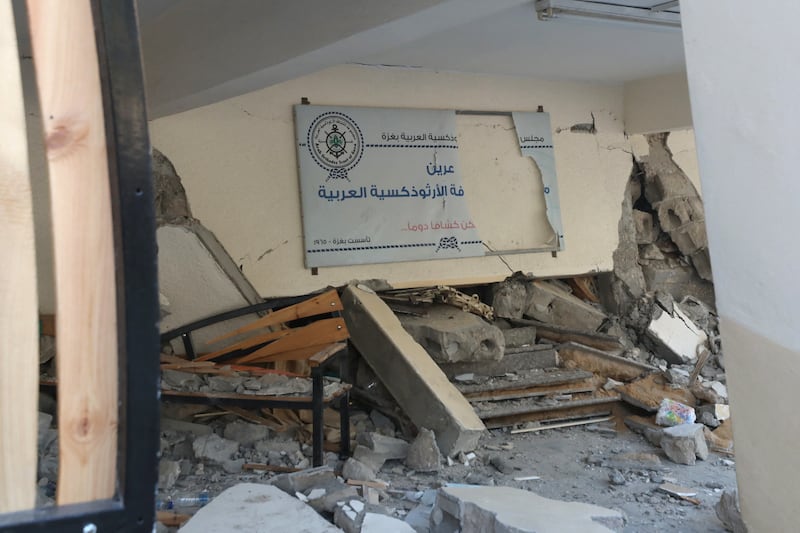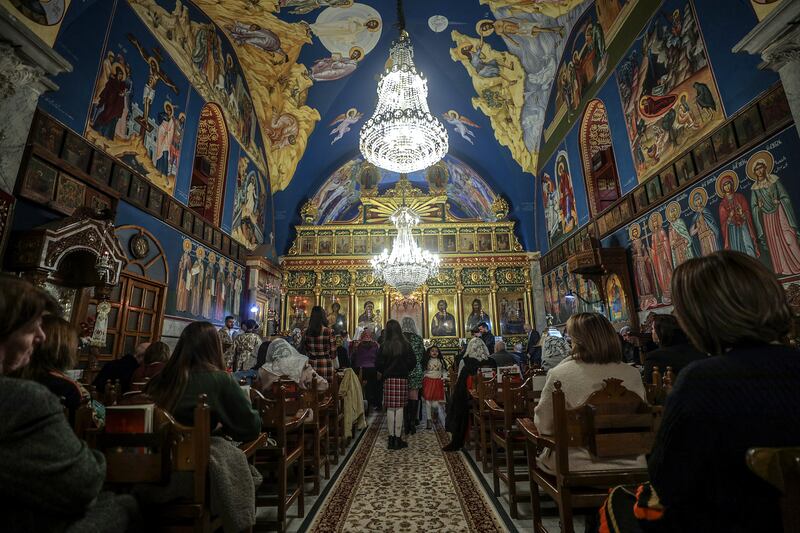For hundreds of years, empires and armies have come and gone in Gaza, but holy service at the Church of Saint Porphyrius has continued. The rituals have carried on in recent weeks as Israeli forces moved on Gaza City, bombs fell and fighting raged on the streets outside.
Despite the battle around them, Greek Orthodox priests dressed in gold-trimmed cassocks have carried on holding Mass for the hundreds taking shelter in the church. Built on a site first consecrated in the fifth century, this house of God has become a wartime home for many of the enclave’s Christian community.
Gaza’s entire population of Christians numbers just 800 to 1,000 people – and almost all of them are now hiding in Saint Porphyrius and the nearby Holy Family Church, part of the Gaza City’s last remaining Catholic parish.
“These two churches are hosting 340 families, which account for almost all the Christians in Gaza,” said Ram Tarazi, who used to run an Orthodox cultural centre before the war, which has been destroyed by an Israeli air strike.
READ MORE
[ In Gaza, one commodity is not in short supply: self-delusionOpens in new window ]
About 20 of the Tarazis, a large clan of Palestinian Christians, fled their homes in Gaza City for the relative safety of Saint Porphyrius, which was named after a fifth century bishop who first established a church on the site to replace a pagan temple.
“We left the same night under bombardment,” said Tarazi, reached by phone on the church grounds. “Our homes are in three buildings next to each other, but after more than a month here, we are not even sure they are still standing.”
Families sheltering in Saint Porphyrius, a compound centred on a renovated church first built by 12th century crusaders, sleep on mattresses laid on the floors of buildings that served as offices for employees and residences for priests. Solar panels provide a small amount of power, just enough for people to charge their phones. Bored children play in open spaces inside the walled compound.
Like the other 2.3 million Palestinians in the enclave, the Christians of Gaza live in fear of Israel’s relentless air campaign and its tanks rolling on streets nearby. There is little food left in the churches and almost nothing to buy in nearby shops. Tarazi said Saint Porphyrius still has a small amount of fuel, which is used sparingly to pump drinking water.
Israel considers Gaza City to be the centre of gravity for Hamas, the militant group it has vowed “destroy” after it led a cross-border rampage October 7th that killed about 1,200 people, according to the government. Palestinian health officials in the Hamas-controlled territory say more than 11,470 Gazans have been killed since Israel launched its military campaign.

Even in churches, the Christians have no assurance of safety. An Israeli air strike on October 19th destroyed one of the buildings sheltering families in the Saint Porphyrius compound, killing 17 people, including four of Tarazi’s relatives. They were buried in the grounds of the church.
Ramez Soury, who lost his three children – Suhail, Julia and Majd – told Jazeera TV: “We came here seeking safety, a last resort in the house of God . . . There is nothing military here.” Ten members of the Soury family were killed in the air strike.
The Israeli military said the church was not the intended target, saying the aim was to hit a Hamas command centre nearby; an internal review has begun.
Mitri Raheb, a Lutheran pastor who is also the president and founder of Dar al-Kalima University in Bethlehem, said the presence of Christians in Gaza was “as old as Christianity”. “Gaza is mentioned eight times in the New Testament,” he said.
Yet even before the war, the Christian population in the enclave was dwindling. There were 1,750 Christians in Gaza in 1997, according to Raheb, a figure that has since halved. Many have sought opportunities to escape the restricted life in the impoverished territory that has been blockaded by Israel and Egypt since the militant group Hamas took control in 2007.
“A third of those who left moved to Bethlehem, taking advantage of Israeli permits to go there for Christmas [before] staying on,” said Raheb, “Others have emigrated.”
[ Emboldened Israeli settlers seek to tighten grip on West BankOpens in new window ]
Metri, whose university Dar al-Kalima runs a cultural outpost in Gaza, fears Israel is adopting a “scorched earth strategy” in Gaza “so it cannot be habitable again”.
Hundreds of thousands of residents of north Gaza have moved to the south following repeated Israeli orders to evacuate “for your safety”. But many of the displaced Christians are afraid to make the journey south.
“It is too dangerous. At least at the church they have a roof over their heads,” said Hanna Maher, a former pastor of the Gaza Baptist Church, whose wife, Janet, is Ramy’s sister. She and their three children are with the family in Saint Porphyrius. “People have tried to leave more than once, but they were caught up in the clashes and killed.”

Maher said that Elham Farah, an 84-year old music teacher who had taken refuge in the Holy Family Church, was on Sunday shot in the leg by a bullet when she went out to check if her home was still standing. She died on the street, according to Maher and a Catholic priest in Bethlehem. It was too dangerous for anyone to come to her rescue.
Maher, an Egyptian, was on a visit to his home country when the war broke out and he could not return to Gaza. He has been spending much of his days trying to contact his wife on the phone. “Sometimes two days pass before I am able to reach her,” he said.
Temperatures are falling and Maher is concerned there is nowhere to buy warm clothes for his children. Tarazi, meanwhile, is worried the supplies of food may not last the week. “The drinking water is not very clean, and we have a small stock of medicines,” he said. “We just want the war to end.” – Copyright The Financial Times Limited 2023




















